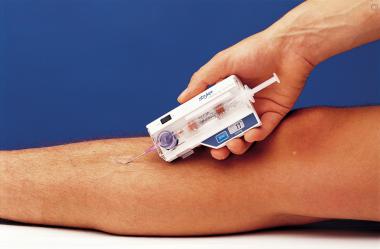Acute compartment syndrome is serious and possibly life-threatening condition that involves having increased pressure in a specific muscle compartment. The increased pressure interferes with muscle function, nerve function and with blood flow the area and possibly the blood flow past the area of compartment syndrome.
There are thick layers of tissue called fascia. They separate groups of muscles in the arms and legs so they aren’t connected to one another. The thick layers of fascia enclose a confined space, called a compartment. A compartment involves all the muscles encased by the compartment plus the nerves and blood vessels that innervate the body in the compartment and distal to the compartment. The fascia surrounds these structures and keeps them all in one place.
Unfortunately, fascia does not expand so if there are increased pressures within the compartment, there will be increased pressure in the muscles, nerves and blood vessels. The blood flow can be completely blocked off and the nerves will have diminished function. Muscle can die if the disorder isn’t treated right away by a trained physician, When muscle dies, this becomes a permanent injury that might lead to significant surgery or possible an amputation of the affected limb.

The kinds of injury that leads to acute compartment syndrome include trauma from a crush injury, surgery, or an automobile accident. Complex fractures can contribute to compartment syndrome.
Chronic compartment syndrome is usually caused by repetitive motion, like running. The pressure is only increased when the person is doing that activity. Compartment syndrome is most common in the lower leg and forearm but it can occur in the upper leg and upper arm. It can also occur in the hand and foot as well.
Compartment syndrome is extremely painful and doesn’t go away when you take pain medication or raise the affected area. Symptoms include decreased sensation at the level of the compartment syndrome and distal to that. There is numbness and tingling and the skin is remarkably pale. The pain increases over time and the extremity is weak.
A physical exam of the affected extremity will show pain when the area is squeezed, extreme pain when the extremity is moved. The diagnosis can be confirmed by directly measuring the pressure in the compartment using a needle attached to a pressure meter, which is placed into the compartment. It should be done before and after there is activity that causes pain.
Treatment involves immediate surgery. Delaying surgery can result in severe damage to the muscles, nerves and blood vessels. The surgeon makes long cuts along the compartment in order to relieve the pressure. The wounds are left open and covered with a moist dressing until the pressure goes down and the wounds can be secondarily closed.
Surgery is needed immediately. Delaying surgery can lead to permanent damage. Skin grafts may be needed to close the wound. If a bandage or cast is too tight, the dressing should be loosened in order o relieve the pressure.
The prognosis is good if there is a prompt diagnosis and treatment. The overall prognosis is actually determined by the mechanism of injury that caused the compartment syndrome. If the diagnosis is delayed, there is permanent nerve injury and a lack of complete muscle function. The diagnosis is delayed often when the person is sedated or unconscious and cannot complain of pain. Permanent nerve injury will occur after 12-24 hours of compression.
Complications of compartment syndrome include permanent injury to nerves and muscles which can severely impair function of the extremity. If the compartment syndrome is severe, amputation may be required. There is no way to prevent this condition but the early diagnosis and treatment will prevent many of the complications. People with casts need to be aware of the possibility of swelling and should see someone at the emergency room or the primary provider if there is increased pain in the cast. For More information visit: GP Negligence Claims

